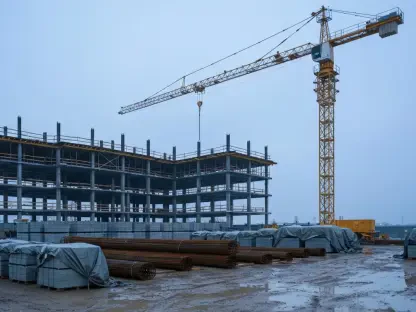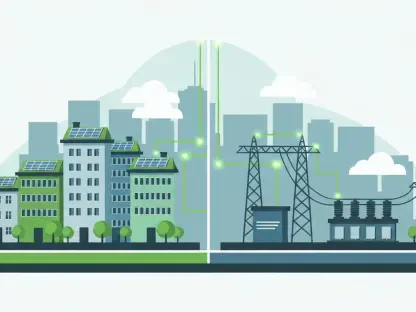In today’s rapidly advancing technological landscape, digital transformation is at the forefront of redefining industries, with data centers becoming essential infrastructure components. The driving force behind this evolution is artificial intelligence (AI), which is poised to revolutionize the U.S. data center construction market. AI is not merely influencing the sector—it is reshaping it, accelerating growth, and facilitating unprecedented opportunities. Amidst this change, companies are increasingly investing in creating and upgrading data center facilities to better accommodate AI’s demanding capabilities. As AI technologies develop and expand their reach, they create ripple effects across data management, processing, and storage needs, orchestrating a new era of productivity and innovation.
AI as a Catalytic Force
Artificial intelligence emerges as a transformative element, reshaping the infrastructure within the U.S. data center sector. Its impact has prompted increased investment in new facilities and the enhancement of existing ones, driven by the necessity to support AI capabilities. OpenAI and similar organizations are leading this transformation, establishing infrastructures tailored specifically to AI processing requirements, such as space-based data centers and AI GPUs. While the current implementation of AI technologies in data centers remains relatively limited, the anticipated expansion is substantial. Companies across various industries are actively strategizing to incorporate AI into their operations, preparing for its pivotal role in future developments. The integration of AI heralds a shift in how data centers are structured and operated, paving the way for more efficient, scalable, and responsive models tailored to meet high-performance computing demands.
Regional Developments and Shifts
Northern Virginia has long held the title as the predominant hub for data center development, but its prominence faces emerging competition. The Southeastern U.S. is gaining recognition as a significant area for data center growth, largely driven by increasing AI demand and expanding cloud services. This shift marks a renaissance in regional developments, as states like Georgia, North Carolina, and Tennessee experience accelerated growth. Strategic initiatives, such as tax exemptions in Georgia, bolster this advancement, providing incentives that attract data center investments. Atlanta, in particular, is witnessing substantial capacity expansion efforts, positioning it as a key player within this reshaping landscape. The growth in these regions suggests a broader distribution of data center capacities across the country, addressing not only technical demands but also promoting economic opportunities. As AI implementation continues to evolve, the localization of data centers reflects an adaptive approach to meet diverse processing needs while optimizing geographic advantages.
Sustainability in Focus
The data center industry’s commitment to sustainability stands as a response to mounting environmental challenges associated with expansive infrastructure demands. Investments in resource-efficient technologies, incorporating innovative cooling systems and renewable energy, signal a shift towards eco-conscious practices. This alignment emphasizes the sector’s resilience and capacity to mitigate environmental footprints while balancing technological growth and environmental stewardship. AI’s computational complexities drive demand for sustainable solutions that adapt to processing needs without compromising ecological viability. Integrating renewable energy sources into operations ensures a cleaner, greener footprint, which maintains the industry’s ability to support increasing demands responsibly. As data infrastructures evolve amidst the AI-driven paradigm, embracing sustainable practices positions the sector to address both operational efficiencies and ecological considerations. This fostering of environmental stewardship represents a critical element in sustaining the industry’s forward momentum, ensuring environmentally responsible growth aligned with broader technological advancements.
Investment Patterns and Sector Dynamics
Investment in U.S. data center construction highlights varying densities and increasingly diverse sector dynamics. Construction costs are rising annually by 5% to 10%, forecasting an average expenditure of $12 million per MW by 2030. These figures underscore the financial commitments and sector complexity involved in addressing the pronounced demand for digital infrastructures. Simultaneously, the construction industry faces skills shortages, with the simultaneous execution of multiple projects exacerbating labor constraints. This challenge is particularly evident in states like Virginia, Georgia, and Texas, which necessitate strategic workforce development initiatives to attract and train skilled personnel. The sector’s evolving investment landscape interplays with dynamics shaped by technological advancements, regional expansion, and strategic renewal. As companies navigate competitive markets, they adapt to rapidly changing demands and align their strategies with growth opportunities, driven by AI’s transformative impact as both a catalyst and a beneficiary of the industry’s ambitions.
Competitive Drive
A wave of competition is sweeping through the industry, as established operators like Equinix and Digital Realty confront challenges from newer entities like Corscale Data Centers. The rise of AI demand amplifies these competitive dynamics, with Bitcoin companies now entering the data center sphere, further diversifying offerings and innovations. This competitive landscape fosters a vibrant ecosystem, ushering in new entrants while catalyzing expansions by existing players into Tier 1, 2, and 3 markets. Such diversity broadens market options and enhances service offerings, stimulating technological advancement and operational efficiencies. The industry’s competitive environment, therefore, evolves as service providers cater to varying demands, leveraging AI’s growth to optimize performance and expand client markets. The influx of novel participants brings fresh perspectives, fostering an era rich with potential and poised to redefine established norms within data center operations.
Geographical Transition in Data Center Hosting
The Southeastern U.S. is increasingly pivotal in hosting data centers, symbolizing essential geographic shifts that transcend traditional tech hubs. Strategic tax exemptions and state-driven growth initiatives catalyze this development, creating a balanced distribution of infrastructure nationwide. Enhanced accessibility and infrastructure availability redefine regional landscapes, providing new avenues for economic growth and technological influence. These areas emerge as critical nodes within the broader data center ecosystem, enabling diverse applications and fostering comprehensive technological integration. Geographic diversification supplies more robust accessibility across various regions while facilitating dynamic market expansions. Aligning infrastructures with local opportunities underscores adaptive strategies that respond to technological advancements and evolving processing needs. This evolving geographic footprint encourages collaborative innovations while promoting economic vigor through optimized infrastructure distributions across broader arrays of locales.
Addressing the Workforce Hurdle
A shortage of skilled workers presents a formidable barrier, with the industry’s rapid pace hindered by workforce constraints. This challenge calls for strategic efforts to rejuvenate recruitment and training processes aimed at cultivating a robust skill set aligned with AI’s integration. As AI adoption progresses, attracting and nurturing talent becomes increasingly crucial, ensuring expertise in managing advanced implementations. Focused actions to bolster workforce capacities will not only address current shortages but also prepare for projected demands as digital transformation accelerates. Companies are prompted to revise traditional recruitment strategies, fostering environments conducive to skills development and professional growth. This emphasis on workforce rejuvenation forms a pivotal component for sustaining the industry’s growth trajectory, meeting both immediate operational needs and positioning for future advancements shaped by technology’s relentless evolution.
Outlook on Future Expansion
Northern Virginia has historically been the leading area for data center development, but now faces growing competition. The Southeastern U.S. is gaining attention as a burgeoning hub for data centers, fueled by rising AI demands and expanding cloud services. This transition signals a transformative period for the region, with states such as Georgia, North Carolina, and Tennessee witnessing rapid growth. Strategic initiatives, like Georgia’s tax exemptions, are catalyzing this progress by providing incentives that draw data center investments. Atlanta, especially, is experiencing notable expansion in capacity, aiming to become a central figure in this evolving landscape. This regional growth indicates a more widespread distribution of data center capacities nationwide, catering to technical requirements while fostering economic opportunities. As AI continues to move forward, the localization of data centers exemplifies a strategic adaptation to address diverse processing needs, leveraging geographic benefits to their full potential.









